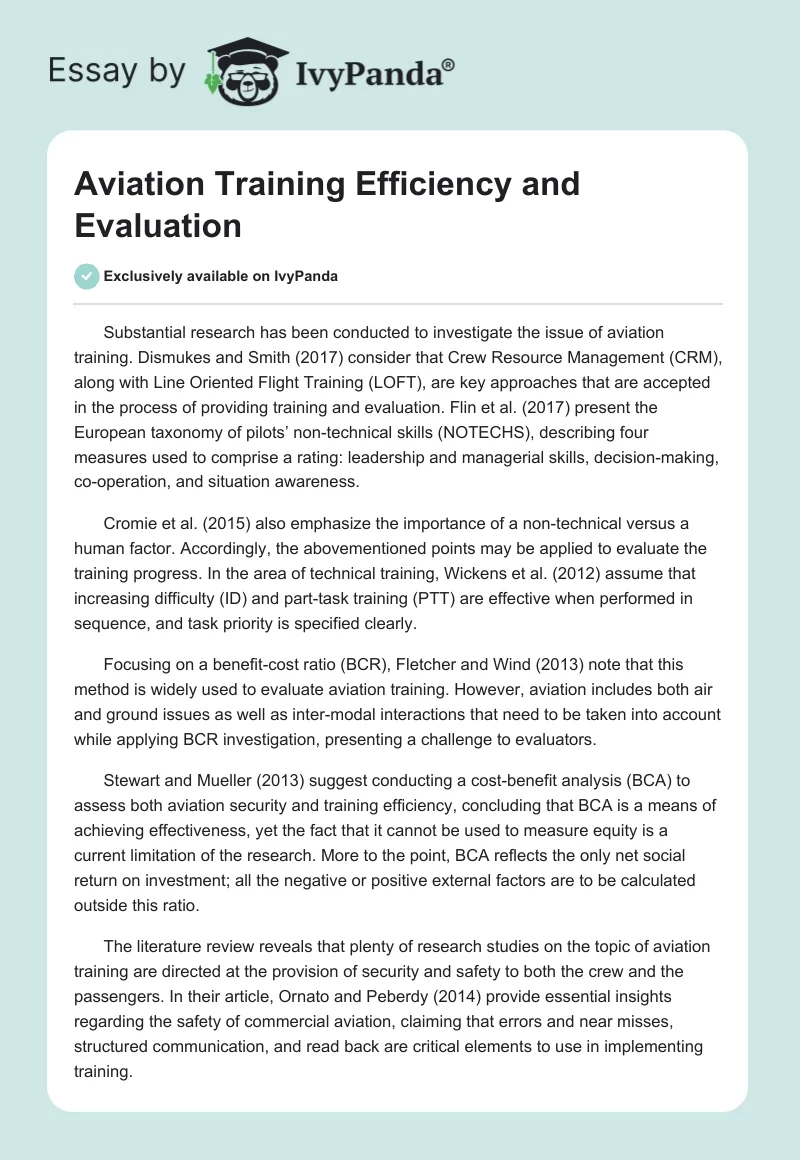Substantial research has been conducted to investigate the issue of aviation training. Dismukes and Smith (2017) consider that Crew Resource Management (CRM), along with Line Oriented Flight Training (LOFT), are key approaches that are accepted in the process of providing training and evaluation. Flin et al. (2017) present the European taxonomy of pilots’ non-technical skills (NOTECHS), describing four measures used to comprise a rating: leadership and managerial skills, decision-making, co-operation, and situation awareness.
Cromie et al. (2015) also emphasize the importance of a non-technical versus a human factor. Accordingly, the abovementioned points may be applied to evaluate the training progress. In the area of technical training, Wickens et al. (2012) assume that increasing difficulty (ID) and part-task training (PTT) are effective when performed in sequence, and task priority is specified clearly.
Focusing on a benefit-cost ratio (BCR), Fletcher and Wind (2013) note that this method is widely used to evaluate aviation training. However, aviation includes both air and ground issues as well as inter-modal interactions that need to be taken into account while applying BCR investigation, presenting a challenge to evaluators.
Stewart and Mueller (2013) suggest conducting a cost-benefit analysis (BCA) to assess both aviation security and training efficiency, concluding that BCA is a means of achieving effectiveness, yet the fact that it cannot be used to measure equity is a current limitation of the research. More to the point, BCA reflects the only net social return on investment; all the negative or positive external factors are to be calculated outside this ratio.
The literature review reveals that plenty of research studies on the topic of aviation training are directed at the provision of security and safety to both the crew and the passengers. In their article, Ornato and Peberdy (2014) provide essential insights regarding the safety of commercial aviation, claiming that errors and near misses, structured communication, and read back are critical elements to use in implementing training.
Consistent with the above study, Hamstra et al. (2014) argue that the so-called “two challenge rule” is necessary as it aids the prevention of omissions during flights. Contributing to the job performance of potential pilots, technical training promotes rapid reactions to any emergencies and provides the flight crew with valuable knowledge and skills (LaPoint 2012; Ricci & Brumsted 2012). The authors stress that CRM training significantly reduces the level of incidents. It should be emphasized that the majority of studies in the field are based on such research strategies as questionnaires, brief / debrief methods, and controlled-randomized trials. Thus, both qualitative and quantitative methods of research are popular among scholars exploring aviation training.
In general, the findings of various studies are consistent. No significant controversies were identified in the course of the literature review, while some limitations are to be noted. According to O’Connor et al. (2017), research-based on questionnaires has revealed that the current methods in CRM evaluations are insufficient to identify aviation training effectiveness.
Hays and Singe (2012) focus on fidelity in training system design and assert that there is a gap between practice and theory since several theoretical provisions cannot be effectively applied in practice. This shows that there is a need to explore evaluation techniques and suggest innovative ways to access training outcomes. Among other unanswered questions, it is important to consider how employee satisfaction levels are affected during aviation training as well as the overall benefit of training to organizations.
Reference List
Cromie, S, Ross, D, Corrigan, S, Liston, P, Lynch, D & Demosthenous, E 2015, ‘Integrating human factors training into safety management and risk management: a case study from aviation maintenance’, Journal of Risk and Reliability, vol. 229, no. 3, pp. 266-274.
Dismukes, RK & Smith, GM 2017, Facilitation and debriefing in aviation training and operations, Routledge, New York, NY.
Fletcher, JD & Wind, AP 2013, ‘Cost considerations in using simulations for medical training’, Military Medicine, vol.178, no. 10, pp. 37-46.
Flin, R, Martin, L, Goeters, KM, Hörmann, HJ, Amalberti, R, Valot, C & Nijhuis, H 2017, ‘Development of the NOTECHS (non-technical skills) system for assessing pilots’ CRM skill’, in E Salas, E Edens & KA Wilson (eds), Crew Resource Management: Critical Essays, Sage, New York, NY, pp. 72-83.
Hamstra, SJ, Brydges, R, Hatala, R, Zendejas, B & Cook, DA 2014, ‘Reconsidering fidelity in simulation-based training’, Academic Medicine, vol. 89, no. 3, pp. 387-392.
Hays, RT & Singer, MJ 2012, Simulation fidelity in training system design: bridging the gap between reality and training, Springer Science & Business Media, New York, NY.
LaPoint, JL 2012, ‘The effects of aviation error management training on perioperative safety attitudes’, International Journal of Business and Social Science, vol. 3, no. 2, pp. 1-12.
O’Connor, P, Flin, R, Fletcher, G & Hemsley 2017, ‘Methods used to evaluate the effectiveness of flightcrew CRM training in the UK aviation industry’, in E Salas, E Edens & KA Wilson (eds), Crew Resource Management: Critical Essays, Sage, New York, NY, pp. 37-52.
Ornato, JP & Peberdy, MA 2014, ‘Applying lessons from commercial aviation safety and operations to resuscitation’, Resuscitation, vol. 85, no. 2, pp. 173-176.
Ricci, MA & Brumsted, JR 2012, ‘Crew resource management: using aviation techniques to improve operating room safety’, Aviation, Space, and Environmental Medicine, vol. 83, no. 4, pp. 441-444.
Stewart, MG, & Mueller, J 2013, ‘Terrorism risks and cost‐benefit analysis of aviation security’, Risk Analysis, vol. 33, no. 5, pp. 893-908.
Wickens, CD, Hutchins, S, Carolan, T & Cumming, J 2013, ‘Effectiveness of part-task training and increasing-difficulty training strategies: a meta-analysis approach’, Human Factors, vol. 55, no. 2, pp. 461-470.


